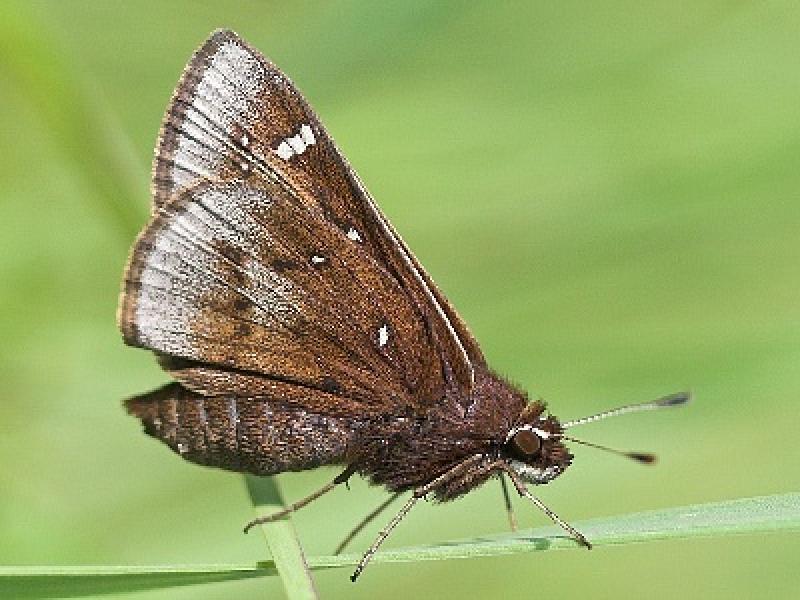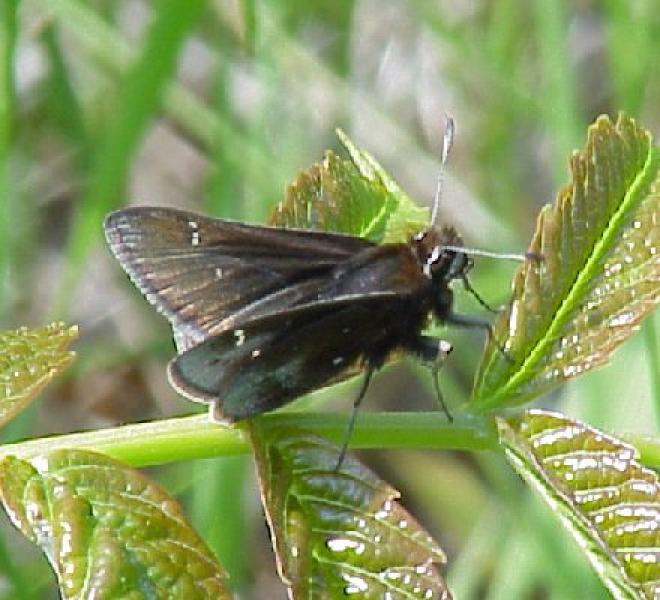Dusted Skipper
Atrytonopsis hianna (Scudder, 1868)
- Class
- Insecta (Insects)
- Family
- Hesperiidae (Skippers)
- State Protection
- Not Listed
Not listed or protected by New York State.
- Federal Protection
- Not Listed
- State Conservation Status Rank
- S2S3
Imperiled or Vulnerable in New York - Very vulnerable, or vulnerable, to disappearing from New York, due to rarity or other factors; typically 6 to 80 populations or locations in New York, few individuals, restricted range, few remaining acres (or miles of stream), and/or recent and widespread declines. More information is needed to assign either S2 or S3.
- Global Conservation Status Rank
- G4G5
Apparently or Demonstrably Secure globally - Uncommon to common in the world, but not rare; usually widespread, but may be rare in some parts of its range; possibly some cause for long-term concern due to declines or other factors. More information is needed to assign either G4 or G5.
Summary
Did you know?
In New York, the Dusted Skipper can be found along utility rights-of-way in pine barrens and other sandy habitats. It may also be found on rock outcrops in the New York City area.
State Ranking Justification
Dusted Skipper has a somewhat limited range in New York where it is found in openings with bluestem grasses, such as pine barrens habitats. In addition, these habitats have been greatly reduced, largely due to development and succession. However, the overall range has not significantly changed.
Long-term Trends
Although the long-term trend is unknown, there probably are fewer occurrences now than historically, even though the overall range in New York does not appear to have changed.
Conservation and Management
Threats
The main threats to this species are habitat alteration, fragmentation, and degradation (NatureServe 2022). In New York and other northeastern states, sites such as utility rights-of-way and old railway beds are known to support this species. Therefore, increased use of herbicides, invasion of weedy or invasive plants, and improper management of these areas also threaten these populations (NatureServe 2022). In some parts of its range excessive prescribed burning may also pose a threat (NatureServe 2022).
Conservation Strategies and Management Practices
The best management strategy for this species is the management of the natural community, or habitat, where this species occurs. Researchers have determined that "an active fire management program utilizing prescribed fire with appropriate mechanical treatments" is the preferred method in pitch pine-oak forest communities (Jordan etal. 2003). Researchers have also determined that the size, type, intensity, and timing of fires (pyrodiversity) needs to be evaluated for each site to maximize benefits to the natural community and the species it supports (Jordan et al. 2003). The pitch pine-oak forest community, where this moth occurs, requires moderate intensity fires. The entire occupied habitat for a population should not be burned in a single year (Schweitzer et al. 2018). For example, in places where prescribed burning is used, refugia (unburned areas) are needed for many species to ensure that any life stage can survive a fire. The pitch pine-oak forest community, where this butterfly occurs, requires moderate intensity fires. This species does not survive fire well (Schweitzer et al. 2018).
There are also managment concerns along utility rights-of-way and old railroad beds. Invasive and weedy plants in these areas can out compete native food plants therefore proper management and removal of these species should be considered. The use of herbicides and insecticides to control invasive plants and insects can be done if used carefully (Schweitzer et al. 2018). Large broadcasting of herbicides or insecticides can cause negative effect to host plant species or cause mortality (Schweitzer et al. 2018). As with managing natural habitats, timing to reduce the impact on the species is important, in addition to providing refugia.
Research Needs
The response of this species to the management practices at the Albany Pine Bush and in Saratoga County should be investigated.
Habitat
Habitat
Throughout its geographic range the Dusted Skipper is known to inhabit bluestem grasslands, prairie remnants, and wood openings in acid pine or pine-oak barrens (Conserve Wildlife Foundation of New Jersey 2022). In New York, the Dusted Skipper inhabits mostly openings and utility rights-of-way in pine barrens and other sandy habitats. This species also occasionally inhabits various types of rock outcrops in the New York City area. The adults are rarely seen more than a few feet from the larval foodplant, bluestem grasses (typically Little Bluestem (Schizachyrium scoparium)), unless they are forced into adjacent habitats to find nectar.
Associated Ecological Communities
- Chestnut oak forest
(guide)
A hardwood forest that occurs on well-drained sites in glaciated portions of the Appalachians, and on the coastal plain. This forest is similar to the Allegheny oak forest; it is distinguished by fewer canopy dominants and a less diverse shrublayer and groundlayer flora. Dominant trees are typically chestnut oak and red oak.
- Dwarf pine plains
(guide)
A woodland community dominated by dwarf individuals of pitch pine and scrub oak that occurs on nearly level outwash sand and gravel plains in eastern Long Island. The soils are infertile, coarse textured sands that are excessively well-drained.
- Pitch pine-oak forest
(guide)
A mixed forest that typically occurs on well-drained, sandy soils of glacial outwash plains or moraines; it also occurs on thin, rocky soils of ridgetops. The dominant trees are pitch pine mixed with one or more of the following oaks: scarlet oak, white oak, red oak, or black oak.
- Pitch pine-oak-heath woodland
(guide)
A pine barrens community that occurs on well-drained, infertile, sandy soils. The structure of this community is intermediate between a shrub-savanna and a woodland. Pitch pine and white oak are the most abundant trees.
Associated Species
- Cobweb Skipper (Hesperia metea)
Range
New York State Distribution
The range includes the Albany Pine Bush north to the Saratoga sand plains, the New York City area north to Westchester County (Glassberg 1993), and Long Island. It could possibly turn up in other southeastern New York counties, as well.
Global Distribution
The range is somewhat discontinuous from New Hampshire west across the Great Lakes states to southern Manitoba and the western Dakotas, eastern Wyoming, and central Colorado. It also ranges southward to the Gulf states and Texas (Opler and Krizek 1984, Stanford and Opler 1993, Opler 1994).
Identification Comments
Identifying Characteristics
This species has a wingspan of 3.2-4.3 cm and can be described as having white spots along its brown fringes. The top side of the wings are gray to black in color with males exhibiting a small stigma on their forewing. The bottom of the hindwing is gray in color with white dusting traveling to the end of the wing. The base of the wing typically has at least one white dot.
Characters Most Useful for Identification
The habitat and time of year are strong clues for identifying this species. The white spot near the base of the underside of the hindwing is diagnostic if present. Otherwise, note the white above the eyes, the relatively straight thin line of apical spots, and the details of the underside color and pattern. There is no orange or yellow present on any surface.
Best Life Stage for Proper Identification
This species should be identified from adults, although an expert could identify the larva.
Behavior
A localized late spring skipper always found near bluestem grasses, usually in sandy openings. Adults are diurnal (NatureServe 2021).
Diet
In New York the primary, and possibly exclusive, larval foodplant is Little Bluestem grass (Schizachyrium scoparium), but Big Bluestem (Andropogon gerardii) and other species of Andropogon grasses might also be used. The adults take nectar from a variety of native and non-native flowers (NatureServe 2021).
Best Time to See
The adults occur for about two or three weeks in the spring, usually beginning to appear by the end of May. The larvae are probably mature by September and hibernate fully grown or nearly so, with pupation in the spring.
- Reproducing
- Larvae present and active
- Pupae or prepupae present
The time of year you would expect to find Dusted Skipper reproducing, larvae present and active, and pupae or prepupae present in New York.
Dusted Skipper Images
Taxonomy
Dusted Skipper
Atrytonopsis hianna (Scudder, 1868)
- Kingdom Animalia
- Phylum Arthropoda
(Mandibulates)
- Class Insecta
(Insects)
- Order Lepidoptera
(Butterflies, Skippers, and Moths)
- Family Hesperiidae (Skippers)
- Order Lepidoptera
(Butterflies, Skippers, and Moths)
- Class Insecta
(Insects)
- Phylum Arthropoda
(Mandibulates)
Additional Resources
References
Allen, T.J., J.P. Brock, and J. Glassberg. 2005. Caterpillars in the field and garden. Oxford University Press, New York. 232 pp.
Brock, J. P., and K. Kaufman. 2003. Butterflies of North America. Kaufman Focus Field Guides, Houghton Mifflin Company, New York, NY 284 pp.
Conserve Wildlife Foundation of New Jersey. 2022. New Jersey endangered and threatened species field guide [web application]. Conserve Wildlife Foundation of New Jersey, Princeton, New Jersey. Available http://www.conservewildlifenj.org/ . (Accessed: February 4, 2022).
Glassberg, J. 1993. Butterflies through binoculars: A field guide to butterflies in the Boston-New York-Washington region. Oxford University Press: New York. 160 pp.
Glassberg, J. 1999. Butterflies Through Binoculars: The East. Oxford University Press, New York, New York. 400 pp.
Gochfeld, M. and J. Burger. 1997. Butterflies of New Jersey. Rutgers University Press: Rutgers, New Jersey. 327 pp.
Iftner, D. C., J. A. Shuey, and J. V. Calhoun. 1992. Butterflies and Skippers of Ohio. Ohio Biological Survey Bulletin. New Series, Vol. 9, no. 1, xii + 212 pp., 40 color plates.
Jordan, M. J., W. A. Patterson III, A. G. Windisch. 2003. Conceptual ecological models for the Long Island pitch pine barrens: implications for managing rare plant communities. Forest Ecology and Management 185, 151-168.
NatureServe. 2021. NatureServe Explorer [web application]. NatureServe, Arlington, Virginia. Available https://explorer.natureserve.org/. (Accessed: July 12, 2021).
NatureServe. 2022. NatureServe Explorer [web application]. NatureServe, Arlington, Virginia. Available https://explorer.natureserve.org/. (Accessed: March 1, 2022).
New York Natural Heritage Program. 2024. New York Natural Heritage Program Databases. Albany, NY.
O'Donnell, J.E., L.F. Gall., and D.L. Wagner, eds. 2007. The Connecticut Butterfly Atlas. State Geological and Natural History Survey of Connecticut, Department of Environmental Protection, Hartford. 376 pp.
Opler, P. A. 1994. County Atlas for Eastern United States Butterflies. National Biological Service. Fort Collins, CO.
Opler, Paul A. and G. Krizek. 1984. Butterflies East of the Great Plains. The Johns Hopkins University Press, Baltimore.
Pyle, Robert Michael. 1981. The Audubon Society Field Guide to North American Butterflies. Alfred A. Knopf, Inc., New York. 915 pp.
Schweitzer, Dale F., M. C. Minno, and D. L. Wagner. 2018. Rare, declining, and poorly known butterflies and moths (lepidoptera) of forests and woodlands in the eastern united states. U.S. Forest Service.
Scott, J. A. 1986. The Butterflies of North America: A Natural History and Field Guide. Stanford University Press, Stanford, California.
Shapiro, A.M. 1974. Butterflies and skippers of New York State. Search 4:1-60.
Shapiro, Arthur M. 1966. Butterflies of the Delaware Valley. The American Entomological Society. Special Publication. 79pp.
Stanford, R. E. 1981. Hesperiodea. In: Ferris, C. D. and F. M. Brown. Butterflies of the Rocky Mountain States. University of Oklahoma Press, Norman. pp. 67-140.
Stanford, Ray E. and Paul A. Opler. 1993. Atlas of Western USA Butterflies. Denver and Fort Collins, Colorado. 275 pp.
Links
About This Guide
This guide was authored by: Every, Zane W.
Information for this guide was last updated on: June 30, 2022
Please cite this page as:
New York Natural Heritage Program. 2024.
Online Conservation Guide for
Atrytonopsis hianna.
Available from: https://guides.nynhp.org/dusted-skipper/.
Accessed July 27, 2024.

